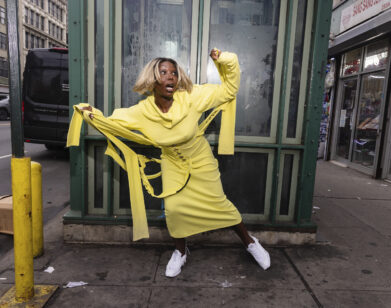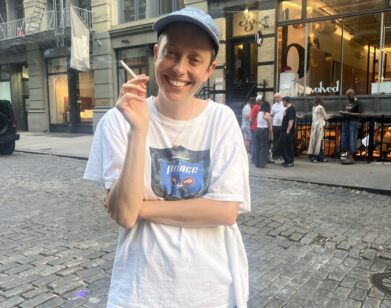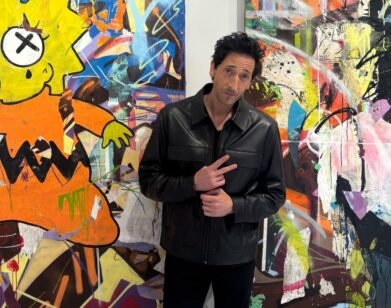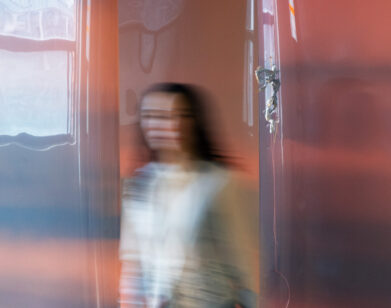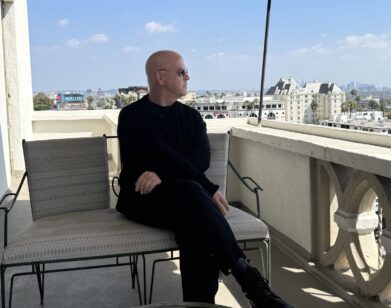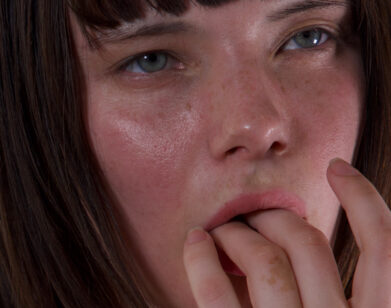Fashion Plates
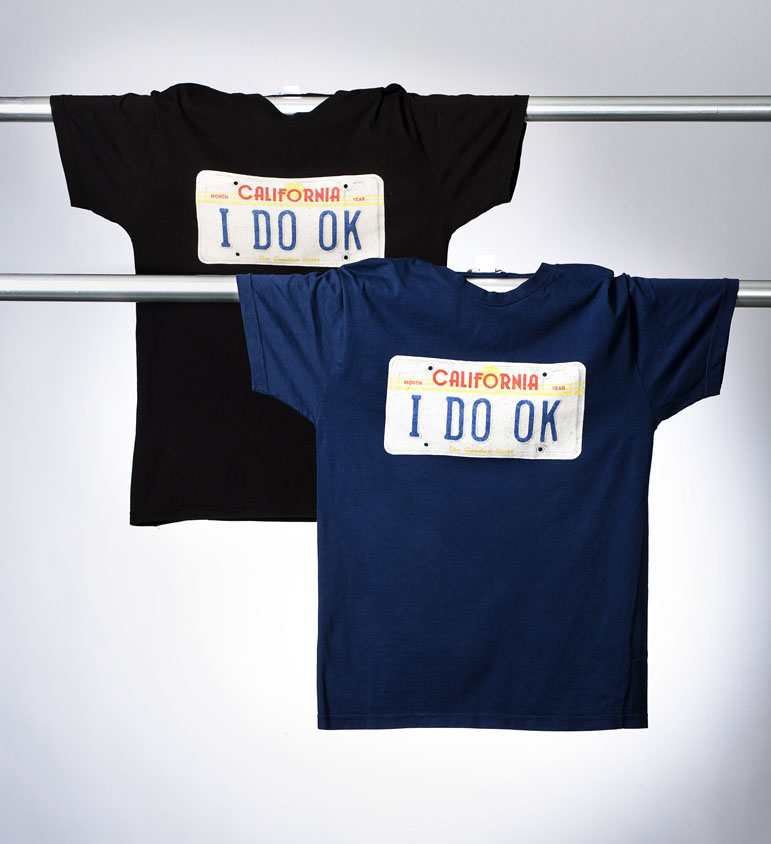
From Adam Kimmel’s Fall/Winter 2008 lookbook; T-shirts for Adam Kimmel
Moscow-born, New York-based artist Kon Trubkovich was raised in Communist-era Russia and has made a career out of exploring the various contradictions of escape—from freedom, as it were. He makes videos featuring inmates—often times turned fugitives—in jumpsuits, and paintings based on the static-ridden stills. His break-out work is a triptych piece, A Thriller is a Thriller is a Thriller, where appropriated footage from the Attica prison riots were synched to Michael Jackson’s “Thriller”. It’s absurd, and it’s a darkly comic take on what an orange jumpsuit has come to represent.
Menswear designer Adam Kimmel is also known for his jumpsuits, and more generally for his updates on American workwear. Since 2005, Kimmel has used New York artists as his muses and models—age and gender being no issue, and they range from the wisened, wisecracking assemblage artist George Herms to the stunning painter of cat eyes, Rita Ackermann. (You’ll also find Interview‘s own Glenn O’Brien and Christopher Bollen.) To bring it all home, Kimmel’s Fall/Winter 2009 collection was inspired by 60s-era Ferus Gallery in LA, which debuted Warhol’s soup cans. Trubkovich has featured in Kimmel’s lookbooks before, and now they have collaborated on a line of T-shirts, available at thecorner.com, featuring the artist’s drawings of cheeky license plates.
Trubkovich recently turned 30, and it’s shaping up to be a milestone year. He will participate at an offsite show at the Athens Biennial this summer; in September, he will have a solo show at Museum 52 in London. Herein he explains where he traveled to in the Nevada desert wearing a jumpsuit, how to forge Russian poetry from American license plates, and why he is newly anxiety-free.
FAN ZHONG: Happy 30th birthday, Kon.
KON TRUBKOVICH: Thanks, I just turned 30 like a week and a half ago.
FZ: How do you feel?
KT: I love it, man.
FZ: You do? Most people get this anxiety when they turn 30.
KT: No, I had my anxiety when I was 29.
FZ: I think I’m having mine extra-early, right now.
KT: Yeah, 29 was my year when everything seemed … I was lost for a little bit. Now I’m ready for it.
FZ: This is like phase two. You have a pretty big year coming up.
KT: I think so. It’s definitely a lot of work. In the past four or five months I’ve really put the blinders on and disappeared into my studio.
FZ: How did you come to do these T-shirts with Adam Kimmel?
KT: I ran into him on the street one day, and he asked me if I was into doing something. I just went to the studio and came up with it on the fly. You thought we might get our lawyers involved?
FZ: And your gallerist, and your accountants …
KT: No, no. Adam’s a pretty easygoing dude.
FZ: So these T-shirts are of your license plate series?
KT: I’ve been doing license plates for a year and a half now. Adam asked for a bold design, so I gave him this pencil drawing that he printed on the tee.
FZ: And I’ve seen you in his lookbook before.
KT: Yeah, I did a few of them. You just spend a day at Adam’s studio, he buys lunch, we all hang out for a bit and then we leave.
FZ: Have you thought about using one of his jumpsuits in one of your videos?
KT: I have. I just did a video in Nevada and I thought about asking him for a jumpsuit, but it was so last minute. But yes, definitely.
FZ: Does he make an orange jumpsuit?
KT: No, I’d have to dye it. I think maybe that was the reason it didn’t work out.
FZ: I’ve seen Chris [Bollen] wear one, it’s navy and made of terry cloth. It looks so comfortable.
KT: I wear them a lot when I work, but I don’t know if I could rock the jumpsuit all day long. Oddly, it’s either really loose or really confining. There’s something strange about a one-piece. But, that being said, Adam’s are about as good as they get.
FZ: You’re having a big solo show in London at Museum 52 in September.
KT: Yeah, I’ll be showing the video that I shot in Nevada. I’ll actually be showing it first at an offsite show of the Athens Biennial, then at Museum 52. The video is inspired by Double Negative, one of Michael Heizer’s Earth pieces. He made this piece in the desert of two negative spaces cut out of heads of a mesa, facing each other. I went to that spot and shot a video performance. There’s also going to be a series of paintings and drawings from that.
FZ: What exactly is the video?
KT: The camera follows me as I enter one side of the trench and exit the other, dressed as a fugitive. It’s about half a mile, pretty serious terrain. You’re climbing and falling. It’s kind of an embarrassment.
FZ: There’s an entry and an exit. So it’s not entirely circular, like some of your past videos. Ant Farm, for example.
KT: Exactly. The idea is that when you exit there’s a transformation that takes you to another station, or way of thought. Though the totality is circular, of course there is a beginning and end to each idea.
FZ: I can’t wait to see that video. Is anything else going to be at this show?
KT: Well, I’m starting to write poems made up of license plates. I’m still writing them, I haven’t even started drawing the plates. I’m going to sequester myself in upstate New York for the summer and write poetry.
FZ: Have you written poetry before?
KT: Well, bad poetry. They would have to be bad.
FZ: It wouldn’t be any fun it were good. Do you have a format in mind? Haiku?
KT: Not a haiku. I was thinking about absurdist Russian poetry, Daniil Kharms in particular. He’s amazing. I read it in Russian. There’s a meter to it that is so-I hate to use the word stupid, but that is what it is. He’s pretending to be bad, in a really, really good way. I’m starting to read him and some [Vladimir] Mayakovsky. Maybe some Bukowski as well. I’m deathly afraid of poetry—I never read it and I don’t get it. That’s probably why I want to do this.
FZ: I think that’s part of the appeal: that you don’t get all of it.
KT: I mean I literally do not know how to read it.
FZ: [Laughs] So you’re going to read Russian poetry to inspire you to make American license plates.
KT: Yes. They are essentially communiqués from this fugitive character. The license plates are his way of communicating to the civilian world. He represents a departure from captivity, this journey that is forever failing and renewing the search for freedom. Which to me is a metaphor for art-making or being an artist.
FZ: Which is your recurring theme.
KT: It’s what I’m interested in. Through that, other things come along-I’m very interested in borders, nationalities, migration, and cultural identity.
FZ: I think it sometimes takes a foreign artist or writer to make the most salient comments on American culture. Like Gardar [Eide Einarsson], who is doing a lot of that right now. Or [Vladimir] Nabokov, even.
KT: Interesting that you mentioned Gardar. I think it’s easy to see certain things when you know very little of the language. There’s a certain observational necessity. On the other hand, there are a lot of great American artists who hit it right on the head, like [Ed] Ruscha. They are more playful. I think my work is a lot more …
FZ: Heavy?
KT: … Russian.

